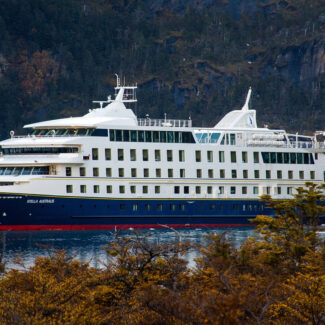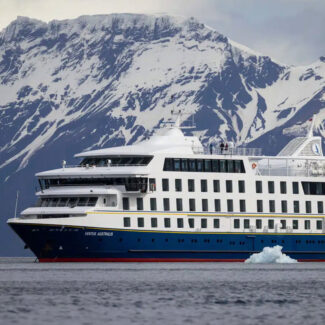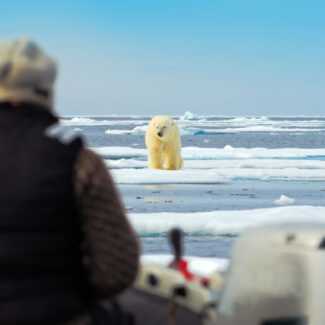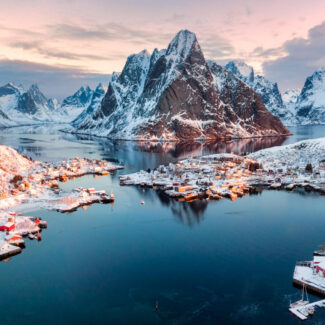A History Of Arctic Exploration (Including Timeline)
The Arctic was one of the last regions on Earth to be comprehensively mapped and scientifically described. From financial enterprise to unquenchable curiosity and adventurism, this top-of-the-world domain of icy seas, glacierized mountains, and lumbering polar bears has spurred exploration for millennia.
Although we can only glancingly acknowledge them in the following written-record-focused overview of Arctic exploration history, it’s absolutely essential to emphasize that the first and greatest wayfarers in Earth’s northernmost latitudes were indigenous peoples—and to remember that more than 40 such cultures continue to live in the Arctic as they have since time immemorial.
From the earliest intrepid voyages, the Arctic has presented a formidable and often perilous landscape. This stark illustration of a ship gripped by unforgiving ice captures the raw power of the far north, a challenge that has beckoned explorers for centuries, driving a history rich with both discovery and hardship.
Motives for Arctic Expeditions
The motivations that drove peoples, nations, companies, and individuals to foray into the Arctic were and are incredibly diverse. Hunter-gatherers pursuing nomadic and semi-nomadic lifestyles long ago ventured widely into subarctic and Arctic realms, both by land and water, in pursuit of game, fish, and other resources—and to carry out trade and, presumably, satisfy innate human tendencies for exploration and adventure.
Commerce, very often going hand-in-hand with complementary goals of mapmaking, scientific study, and nationalistic expansion, spurred much of the early Eurasian push into the Arctic. The goal of shortening trade and shipping routes between Europe and Eastern Asia—sought via both a Northeast Passage through the Eurasian Arctic and a Northwest Passage through the North American Arctic—resulted in vast new polar and subpolar territories being charted and described.
Commissioned by governments and business interests, the mariners and explorers who carried out the commercially and geopolitically motivated expeditions into the Arctic were certainly also driven, at least in some (most?) cases, by a desire for personal glory and fame.
Scientific curiosity has, as we’ve stated, been a part of Arctic exploration for a long time, and remains a chief impetus for today’s expeditioning, as does that age-old impulse of our species to foray into the unknown, with quests to be the first to achieve one or another polar feat continuing to obsess modern-day adventurers.
A History of Arctic Exploration
Arctic journeys have transpired for tens of thousands of years in one form or another, though many of them have gone undocumented or preserved only by oral tradition. The following is but a brief sketching-out of Arctic-exploration history, with numerous links to more detailed articles on various subjects, expeditions, and explorers.
Imagine the world’s edge as early explorers first encountered it – a breathtaking expanse of ice and sea. This view hints at the formidable beauty and the immense challenges that awaited those who dared to venture into the Arctic’s early, mysterious embrace.
Early Period
We’ve already stressed how long indigenous peoples—such as the Inuit, the Yupik, the Chukchi, the Nenets, the Saami, and their ancestors—have hunted, gathered, herded, and explored in the Arctic. Such human presence in the circumpolar realm dates back tens of thousands of years. “Early” doesn’t necessarily do such a presence justice: The “Ancient” period of Arctic discovery would be more accurate.
In terms of the written record, early Arctic exploration includes the semi-mysterious but certainly astonishing voyage of an enterprising Greek merchant named Pytheas, documented in his work Peri tou Okeanou (On the Ocean) and the writings of later authors such as the geographer Strabo. In about 330 BCE, Pytheas embarked from his home in Massilia (today’s Marseille, France) and sailed along the coast of Great Britain, into the northern Scottish archipelago of the Orkneys, then into the rough waters of the North Sea. After some six days of open-sea ranging, Pytheas reached a landmass he called Thule, which has been interpreted as being everything from present-day Norway (more likely) to Iceland (less likely).
Beyond Thule, Pytheas writes of a sea “where neither earth, water, nor air exist separately, but a sort of concretion of all these, resembling a sea-lung”—“sea-lung” being an Ancient Greek word for a mass of jellyfish. Many authorities believe the Greek explorer was describing the patterned form of sea ice known as “pancake ice.” Some speculation puts Pytheas as far north as the Arctic Ocean.
The seafaring Norsemen known as the Vikings made extensive journeys into the subarctic and at least somewhat above the Arctic Circle. In about 850 CE, Vikings are thought to have spied then-uninhabited Iceland (just south of the Arctic Circle); Norse settlement there is popularly dated at about 874.
It may have been the quest for walrus tusks—the ivory from which was a lucrative trade item in medieval Europe—which prompted Erik the Red and his fleet of Viking longships to discover Greenland, which resulted in long-lasting Norse occupation of the southern and southwestern coast of that giant island. That settlement—which apparently predated the arrival, farther north, of the immediate ancestors of Greenlandic Inuit by a hundred years or more—was probably facilitated by the balmier climate of the so-called Warm Medieval Period, which translated to less extensive sea ice (making a Scandivania-to-Greenland ocean crossing easier) and a longer growing season in Greenland.
A cooling climate, plus various socioeconomic factors in mainland Europe, likely contributed to the extinction of the Norse outposts in Greenland by the 14th century or so. (By then, Vikings had also forayed west as far as the North American continent, having settled Newfoundland—which they called Vinland—by 1021 CE, centuries before Columbus.)
Golden Age (1500s – early 1900s)
From the very end of the 15th century to about the turn of the 20th, vigorous commercial and geopolitical striving saw the wild and remote Arctic slowly but surely mapped and formally documented. A lot of this striving concerned the aforementioned search for a sea lane between Europe and the Pacific coast of Asia, with enormous expenditures of resources made by nations such as England, Denmark, and Russia to identify a feasible Northeast or Northwest Passage.
The Northeast Passage would not be “conquered” until the spring of 1879, when the Swedish Vega Expedition, commanded by the accomplished Arctic explorer Adolf Erik Nordenskiöld, reached the Bering Strait after wintering over in Kolyuchin Bay. And it would be decades later before Roald Amundsen led the first successful crossing of the Northwest Passage on the 1903-1906 Gjøa Expedition. (You can read more about the long quest for the Northwest Passage—now an incredible destination for modern Arctic expedition cruises—right here.)
But from the multiple far-reaching forays into the Canadian High Arctic led by such explorers as John Davis and William Parry to the remarkable and unprecedented Great Northern Expedition mounted by Russia from 1733 to 1743, even the unsuccessful efforts to link the Atlantic and Pacific across the top of the world mapped huge reaches of the Arctic for the very first time.
Besides major undertakings in search of trade routes and shipping lanes, this era also saw extensive tracts of the Arctic, both terrestrial and marine, penetrated by whalers, sealers, and fur trappers. So the thirst for blubber, whalebone, skins, and pelts also put a lot of northern geography on the map, in both North America and Eurasia.
The North Pole was somewhat less of a commercial prize than the Northeast and Northwest passages, although the notion that the ocean around the Pole might be ice-free—an ultimately incorrect concept sometimes called the “Open Polar Sea”—did drive some interest in trying to link the Old and New World over the top of the globe. But by the 19th century, polar explorers were gunning for this extreme location simply to be the first there. Learn more about the quest for the North Pole here and here.
Step into the Golden Age of Arctic exploration with this remarkable 1606 map by Mercator Hondius! As one of the first to visualize the North Pole, it fueled the ambitions of countless explorers who set sail during this era, driven by the quest for new lands and trade routes across the Arctic’s mysterious expanse.
Modern Era
In the 20th century, new technologies and burgeoning scientific inquiry saw the Arctic thoroughly explored and such feats as the first flyovers and ship-surfacings at the North Pole achieved. While the era of Arctic exploration in terms of describing new landmasses and waterways may be over, all manner of scientific exploration—including investigations of the Arctic Ocean seafloor and patterns of ice movement—continues in full force. Much of the research focuses on climate change, as the Arctic is one of the most rapidly warming corners of our planet and the loss of sea ice here comes with massive geophysical, ecological, and societal ramifications.
Arctic Exploration Timeline
The following is a sweeping and non-exhaustive timeline of the history of Arctic exploration. (You might also be keen to check out our timeline of North Pole exploration, which includes some additional milestones not included here.)
- c. 330 BCE: Greek merchant Pytheas makes extensive voyage from Massilia that may have reached Norway and the fringe of the Arctic Ocean
- c. 850: Vikings discover Iceland (to commence Norse settlement there some two decades later)
- c. 985: Erik the Red reaches Greenland on Viking expedition and establishes long-lasting Norse settlements there
- 1021: Norse settlement of present-day Newfoundland, Canada (aka “Vinland”)—first European presence on the North American continent
- June 24, 1497: John Cabot’s Matthew voyage reaches coast of Newfoundland
- April 20, 1534: Jacques Cartier embarks on first of three voyages (1534, 1535-1536, 1541-1542) seeking a water passage across North America to link Europe and the Far East, over the course of which he ventures into the Gulf of St. Lawrence and up the St. Lawrence Seaway
- 1553: Seeking the Northeast Passage, Sir Hugh Willoughby winters on the Kola Peninsula, on the brink of the Arctic
- 1576-1578: Three voyages of Martin Frobisher after the Northwest Passage, each reaching northeastern Canada; first European discovery of Baffin Island and first official Northwest Passage voyage into Arctic waters
- 1585-1587: John Davis leads three voyages seeking the Northwest Passage and charts extensive new territory in the North American Arctic
- 1594: William Barents explores Russian Arctic archipelago of Novaya Zemlya on voyage trying for the Northeast Passage
- 1596: Barents describes Bear Island and Svalbard (mistaking the latter for Greenland); he and Jacob van Heemskerck over-winter in Novaya Zemlya
- May 2, 1602: George Weymouth leaves England in command of the Discovery and Godspeed seeking the Northwest Passage; expedition travels several hundred miles up what became known as the Hudson Strait
- 1610-1611: In the Discovery, Henry Hudson traverses the Hudson Strait and enters Hudson Bay; after mutiny, Hudson, his son, and a number of others are cast adrift in the Bay and never seen again
The celebrated and unfortunate navigator,” Henry Hudson, depicted here abandoned by his crew in the vast expanse of Hudson’s Bay.
Source: Lewis & Brown, lithographer, Public domain, via Wikimedia Commons
- 1633: Cossack expedition descends the Lena River to its Arctic delta
- 1648: Cossack commander Semyon Dezhnyov becomes first European to sail through the Bering Strait between Cape Dezhnyov and Cape Olyutorsky
- 1728: Russian voyage commissioned by Peter the Great and commanded by Vitus Bering explores the Bering Strait, discovers the Diomedes, and enters the Chukchi Sea
- 1732: Russian expedition sails from Cape Dezhnyov across the Bering Strait to reach Cape Prince of Wales, marking first European sighting of Alaska
- 1733-1743: Russia’s Great Northern Expedition surveys vast new areas of Russian Arctic coast from Archangel to Cape Bolshoy Baranov; northernmost point of the Eurasian continent, Cape Chelyuskin, reached
- 1778: On third and last of his transoceanic voyages, Captain James Cook enters the Arctic Ocean via the Bering Strait and sails east along the Alaskan coast, then westward to Siberian shore as far as Cape Schmidt
- 1789: Alexander Mackenzie of the North West Company follows the Mackenzie River to its mouth on Canada’s Arctic coast
- 1806: William Scoresby and son achieve new northernmost record beyond Spitsbergen: 81° 12′ N
- 1819-1825: Sir William Parry’s three voyages questing for the Northwest Passage make extension explorations in the Canadian Arctic Archipelago as far as the Fury and Hecla Strait
- 1822: William Scoresby the younger maps the eastern coast of Greenland
- July 23, 1827: On first formal expedition trying to reach the North Pole, Sir William Edward Parry, a British admiral, and his crew fail in that goal but set a new northernmost record of 82°45′ N on this day
- June 1, 1831: On Victory expedition (1829-1833) seeking the Northwest Passage captained by his uncle, James Clark Ross identifies location of the North Magnetic Pole
- July 1845: Whaling vessels Prince of Wales and Enterprise make last documented sighting of John Franklin’s Terror and Erebus Northwest Passage expedition in Baffin Bay; Franklin Expedition vanishes afterward with complete loss of crew in the Canadian High Arctic
- 1850-1854: As part of voyage searching for the Franklin Expedition, Robert McClure and his crew carry out first known transit of the Northwest Passage (though not done entirely by ship) after their vessel becomes trapped in ice
Trace the journeys of Robert McClure on this historical map. His arduous expeditions, partly by ship and partly on foot across the ice, were the first to prove the existence of a continuous Northwest Passage.
Source: Robert McClure, Public domain, via Wikimedia Commons
- 1859: Search party discovers the “Victory Point Note” left by members of the doomed Franklin Expedition on King William Island
- 1873: Austro-Hungarian expedition on the Tegetthoff fails in west-to-east attempt of the Northeast Passage, but sights the Arctic islands of Franz Josef Land
- 1876: Sir George Nares leads the North Pole-aimed British Arctic Expedition; Commander Albert Hastings Markham’s sledging foray attains new northernmost record of 83° 20′ 26″ N
- 1878-1879: Swedish Vega voyage completes first successful crossing of the Northeast Passage, wintering in Kolyuchin Bay
- 1879-1881: USS Jeannette, trying for the North Pole via new route through the Bering Strait, becomes trapped in sea ice and eventually crushed; most of the crew perishes
- 1882-1883: First International Polar Year declared, with 10 countries collaborating on taking Arctic measurements across nearly a dozen stations
- 1893-1896: Norwegian expedition led by Fridtjof Nansen intentionally locks its ship, the Fram, in the Arctic Ocean sea ice in hopes of drifting over the North Pole—another unsuccessful try
- 1897: In a Swedish endeavor, Salomon August Andrée, Nils Strindberg, and Knut Frænkel attempt to fly a hydrogen balloon from Svalbard to the North Pole, but crash on the sea ice and later perish on Kvitøya
- 1903-1905: William Ziegler’s second polar expedition, this one led by Anthony Fiala, fails to reach the North Pole; ship crushed by sea ice, Pole-bound sledding attempts thwarted, and crew endures prolonged wait at Cape Flora (Franz Josef Archipelago) when relief vessel is delayed
- 1903-1906: Roald Amundsen and small crew of the Gjøa complete first known crossing of the Northwest Passage, and also determines that the North Magnetic Pole moves
Behold the sturdy Gjøa! This small but resilient vessel carried Roald Amundsen and his crew on their groundbreaking expedition from 1903 to 1906, finally achieving the first complete navigation of the Northwest Passage by sea.
Source: Anders Beer Wilse (1865 – 1949), Public domain, via Wikimedia Commons
- April 21, 1908: Frederick A. Cook claims to reach the North Pole along with two Inuit companions, Ahwelah and Etukishook. Cook’s claim quickly comes to be disputed
- April 6, 1909: Robert Peary, Matthew Henson, and four Inuits claim to reach the North Pole—another much-disputed avowal and not widely accepted today
- March 5, 1914: The Russian explorer Georgy Sedov dies on the sea ice close to Rudolf Island, the Franz Josef Archipelago, on attempted sledging trek to the North Pole
- 1914-1915: First Russian crossing of the Northeast Passage achieved as part of the Arctic Ocean Hydrographic Expedition
- 1918-1921: Unsuccessful attempt by Roald Amundsen to drift over the North Pole in the Maud, frozen within sea ice; expedition traverses Northeast Passage, making Amundsen and Helmer Hanssen (also on the Gjøa voyage) first people to transit both Northeast and Northwest passages
- May 1925: First attempted flight to the North Pole led by Roald Amundsen and Linclon Ellsworth in two flying boats out of Spitsbergen fails
- May 9, 1926: Richard S. Byrd and Floyd Bennett claim to fly over the North Pole in the Josephine Ford, though this alleged first flight is disputed
- May 13, 1926: First definitive reaching of the North Pole achieved as a flyover by Roald Amundsen, Lincoln Ellsworth, Umberto Nobile, and crew in the dirigible Norge
- April 15, 1928: Flying from Point Barrow, Alaska to Svalbard, Hubert Wilkins and Carl Ben Eilson make first airplane crossing of the Arctic Ocean
- May 23, 1928: Piloted by Umberto Nobile, the airship Italia takes off from Spitsbergen on Italian expedition; circles North Pole the next day; crash-lands upon sea ice on May 25. Survivors not all rescued until mid-July
- June 18, 1928: French plane attempting rescue of the Italia crew disappears with Roald Amundsen on board
- 1934: Icebreaker Fedor Litke makes first successful single-season crossing of the Northeast Passage, traveling west to east
- 1941-1942: First west-east transit of the Northwest Passage by Henry Larsen and the St. Roch
- 1944: Again captaining the St. Roch, Henry Larsen achieves first single-season crossing of the Northwest Passage
- April 23, 1948: Soviet scientists flown in by plane for several days of research become first undisputed party to set foot at the North Pole
- 1954: Canadian icebreaker HMCS Labrador is first deep-draft ship to cross the Northwest Passage
- August 3, 1958: The USS Nautilus, world’s first nuclear-powered submarine, passes under the North Pole—the first ship to reach it
- March 17, 1959: The USS Skate, another U.S. nuclear submarine, becomes the first ship to surface at the North Pole, breaking through the ice from below to do so
- April 19, 1968: Ralph Plaisted and three men of his crew—the fellow Americans Gerald Pitzl and Walter Pederson and the Canadian Jean-Luc Bombardier—become the first to reach the North Pole by snowmobile
- April 4, 1969: Wally Herbert’s British Trans-Arctic Expedition is the first undisputed party to make it to the North Pole by dogsled
- May 31, 1979: Dmitry Shparo’s seven-person Soviet team is the first to ski to the North Pole
- April 11, 1982: The Transglobe Expedition, led by Sir Ranuph Fiennes, first to cross both geographic poles on same journey
- 1984: First cruise ship traverses the Northwest Passage
- 1986: Will Stegler’s Stegler International Polar Expedition is the first unsupported dogsled expedition to reach the North Pole; on it, Ann Bancroft, becomes first woman at the North Pole
- 1990: Børge Ousland and Erling Kagge are the first to reach the North Pole unsupported by skis
- April 22, 1994: Børge Ousland reaches the North Pole on the first unsupported solo ski trek there
Become the Next Arctic Explorer
Will you be the next Arctic explorer? From the fjordlands of Greenland to the ice-capped mountains of the Canadian Arctic Archipelago, from polar bears and walruses to seabird rookeries and spouting whales, you too can experience the Arctic for yourself on the cruise of a lifetime.
Inspired by the daring explorers of the past? Today, you too can witness the Arctic’s majesty in comfort and safety. Join an expedition cruise to experience the breathtaking landscapes and unique wildlife that have drawn adventurers for centuries – your Arctic story awaits!
Disclaimer
Our travel guides are for informational purposes only. While we aim to provide accurate and up-to-date information, Antarctica Cruises makes no representations as to the accuracy or completeness of any information in our guides or found by following any link on this site.
Antarctica Cruises cannot and will not accept responsibility for any omissions or inaccuracies, or for any consequences arising therefrom, including any losses, injuries, or damages resulting from the display or use of this information.








